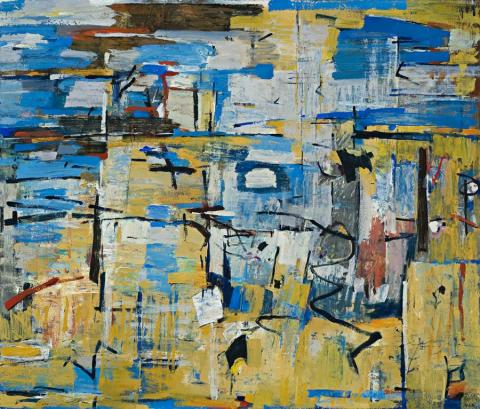BY THE SEA ON AN OVERCAST DAY, 1967
Yvonne Audette
oil on composition board
86.5 x 101.5 cm
signed & dated lower right: Audette / 67
Private collection, Melbourne
Yvonne Audette; 1950s – 2008, Mossgreen Gallery, Melbourne, 2008, cat. 25, (illus.)
Thomas, D., Yvonne Audette; 1950s – 2008, Mossgreen Gallery, Melbourne, 2008, p. 4
When Yvonne Audette returned to Australia she brought with her an international style with its roots in New York, Milan, Rome and Paris. Few if any Australian abstract artists before her could claim such a prestigious background - experiencing at first hand the work of Willem de Kooning, Franz Kline and Barnett Newman, and lifelong friendship with Clement Greenberg and Arnaldo Pomodoro. The dynamics of the art world of New York were married to the sophistication of Europe in an individual blend of engaging elegance. It is not surprising that her first show back in Australia in 1968 was with Robert Klippel at Kym Bonython's brand new Paddington gallery.
On her return to Sydney in 1966, Audette frequently used to walk along the water's edge enveloped in nostalgia. She had been away from her home for such a long time. The overcast day had a particular appeal, combining her mood with 'the tones and colours [which] seemed to have a harmonious discourse with each other.'1 This was the genesis of By the Sea on an Overcast Day , 1967. While such origins can be traced in the watery blues across the sandy yellows of the painting, Audette's creative illusions are of a different kind. 'I knew at that time', she said, 'that if I made it too realistic I would lose the emotion I felt and the structures would weaken.'2 As in this work, her paintings are highly structured or constructed. There is also an affinity with music, a continuing influence often reflected in her choice of titles, and felt in the tonal and colour vibrations, together with the rhythms that flow through her work. This and other abstract paintings of the time delight in a painterly calligraphy intertwined with the other formal elements derived from the inspiration of the landscape.
1. Conversation with the artist 26 July 2009
2. ibid.
DAVID THOMAS
